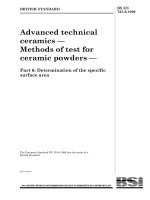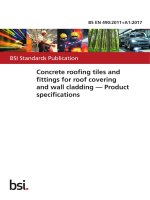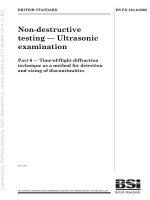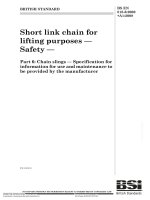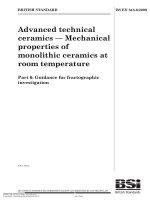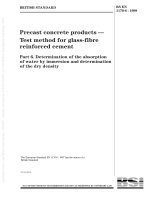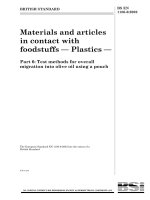Bsi bs en 62282 6 200 2017
Bạn đang xem bản rút gọn của tài liệu. Xem và tải ngay bản đầy đủ của tài liệu tại đây (2.15 MB, 24 trang )
BS EN 62282-6-200:2017
BSI Standards Publication
Fuel cell technologies
Part 6-200: Micro fuel cell power systems —
Performance test methods
BRITISH STANDARD
BS EN 62282-6-200:2017
National foreword
This British Standard is the UK implementation of EN 62282-6-200:2017. It
is identical to IEC 62282-6-200:2016. It supersedes BS EN 62282-6-200:2012
which is withdrawn.
The UK participation in its preparation was entrusted to Technical
Committee GEL/105, Fuel cell technologies.
A list of organizations represented on this committee can be obtained on
request to its secretary.
This publication does not purport to include all the necessary provisions of
a contract. Users are responsible for its correct application.
© The British Standards Institution 2017.
Published by BSI Standards Limited 2017
ISBN 978 0 580 86725 5
ICS 27.070
Compliance with a British Standard cannot confer immunity from
legal obligations.
This British Standard was published under the authority of the
Standards Policy and Strategy Committee on 31 January 2017.
Amendments/corrigenda issued since publication
Date
Text affected
BS EN 62282-6-200:2017
EUROPEAN STANDARD
EN 62282-6-200
NORME EUROPÉENNE
EUROPÄISCHE NORM
January 2017
ICS 27.070
Supersedes EN 62282-6-200:2012
English Version
Fuel cell technologies Part 6-200: Micro fuel cell power systems Performance test methods
(IEC 62282-6-200:2016)
Technologies des piles à combustible Partie 6-200: Systèmes à micropiles à combustible Méthodes d'essai des performances
(IEC 62282-6-200:2016)
Brennstoffzellentechnologien Teil 6-200: Mikro-Brennstoffzellen-Energiesysteme Leistungskennwerteprüfverfahren
(IEC 62282-6-200:2016)
This European Standard was approved by CENELEC on 2016-10-27. CENELEC members are bound to comply with the CEN/CENELEC
Internal Regulations which stipulate the conditions for giving this European Standard the status of a national standard without any alteration.
Up-to-date lists and bibliographical references concerning such national standards may be obtained on application to the CEN-CENELEC
Management Centre or to any CENELEC member.
This European Standard exists in three official versions (English, French, German). A version in any other language made by translation
under the responsibility of a CENELEC member into its own language and notified to the CEN-CENELEC Management Centre has the
same status as the official versions.
CENELEC members are the national electrotechnical committees of Austria, Belgium, Bulgaria, Croatia, Cyprus, the Czech Republic,
Denmark, Estonia, Finland, Former Yugoslav Republic of Macedonia, France, Germany, Greece, Hungary, Iceland, Ireland, Italy, Latvia,
Lithuania, Luxembourg, Malta, the Netherlands, Norway, Poland, Portugal, Romania, Serbia, Slovakia, Slovenia, Spain, Sweden,
Switzerland, Turkey and the United Kingdom.
European Committee for Electrotechnical Standardization
Comité Européen de Normalisation Electrotechnique
Europäisches Komitee für Elektrotechnische Normung
CEN-CENELEC Management Centre: Avenue Marnix 17, B-1000 Brussels
© 2017 CENELEC All rights of exploitation in any form and by any means reserved worldwide for CENELEC Members.
Ref. No. EN 62282-6-200:2017 E
BS EN 62282-6-200:2017
EN 62282-6-200:2017
European foreword
The text of document 105/527/CDV, future edition 3 of IEC 62282-6-200, prepared by IEC/TC 105
"Fuel cell technologies" was submitted to the IEC-CENELEC parallel vote and approved by CENELEC
as EN 62282-6-200:2017.
The following dates are fixed:
•
latest date by which the document has to be implemented at
national level by publication of an identical national
standard or by endorsement
(dop)
2017-07-27
•
latest date by which the national standards conflicting with
the document have to be withdrawn
(dow)
2019-10-27
This document supersedes EN 62282-6-200:2012.
Attention is drawn to the possibility that some of the elements of this document may be the subject of
patent rights. CENELEC [and/or CEN] shall not be held responsible for identifying any or all such
patent rights.
Endorsement notice
The text of the International Standard IEC 62282-6-200:2016 was approved by CENELEC as a
European Standard without any modification.
2
BS EN 62282-6-200:2017
EN 62282-6-200:2017
Annex ZA
(normative)
Normative references to international publications
with their corresponding European publications
The following documents, in whole or in part, are normatively referenced in this document and are
indispensable for its application. For dated references, only the edition cited applies. For undated
references, the latest edition of the referenced document (including any amendments) applies.
NOTE 1
When an International Publication has been modified by common modifications, indicated by (mod),
the relevant EN/HD applies.
NOTE 2
Up-to-date information on the latest versions of the European Standards listed in this annex is
available here: www.cenelec.eu.
Publication
Year
Title
EN/HD
Year
IEC 60068-2-6
-
Environmental testing Part 2-6: Tests - Test Fc: Vibration
(sinusoidal)
EN 60068-2-6
-
IEC 60721-3-7
-
Classification of environmental conditions Part 3: Classification of groups of
environmental parameters and their
severities Section 7: Portable and non-stationary use
EN 60721-3-7
-
IEC/TS 62282-1
2013
Fuel cell technologies Part 1: Terminology
-
-
ISO/IEC 17025
-
General requirements for the competence of
testing and calibration laboratories
EN ISO/IEC 17025
-
3
–2–
BS EN 62282-6-200:2017
IEC 62282-6-200:2016 © IEC 2016
CONTENTS
FOREWORD ......................................................................................................................... 3
INTRODUCTION ................................................................................................................... 5
1
Scope ............................................................................................................................ 6
2
Normative references..................................................................................................... 6
3
Terms and definitions .................................................................................................... 7
4
General principles ......................................................................................................... 8
4.1
Testing environment .............................................................................................. 8
4.2
Minimum required measurement accuracy ............................................................. 8
4.3
Measuring instruments .......................................................................................... 9
4.3.1
General ......................................................................................................... 9
4.3.2
Voltage .......................................................................................................... 9
4.3.3
Current .......................................................................................................... 9
4.3.4
Time .............................................................................................................. 9
4.3.5
Weight ........................................................................................................... 9
4.3.6
Temperature .................................................................................................. 9
4.3.7
Humidity ........................................................................................................ 9
4.3.8
Pressure ........................................................................................................ 9
4.3.9
Vibration frequency ........................................................................................ 9
4.3.10
Volume .......................................................................................................... 9
5
Tests ........................................................................................................................... 10
5.1
Test procedure .................................................................................................... 10
5.2
Power generation characteristics ......................................................................... 10
5.2.1
Starting duration .......................................................................................... 10
5.2.2
Rated power test and rated voltage test ........................................................ 10
5.2.3
Power generation test after idle condition ..................................................... 10
5.2.4
Power generation test at low and high temperatures ..................................... 11
5.2.5
Power generation test under low and high humidity conditions ...................... 11
5.2.6
Altitude test ................................................................................................. 11
5.3
Mechanical durability tests .................................................................................. 12
5.3.1
Drop test ...................................................................................................... 12
5.3.2
Vibration test ............................................................................................... 12
6
Labelling and marking .................................................................................................. 13
7
Test report .................................................................................................................. 13
Bibliography ....................................................................................................................... 17
Figure 1 – Micro fuel cell power system block diagram ........................................................... 6
Table 1 – Drop height ......................................................................................................... 12
Table 2 – Vibration condition ............................................................................................... 13
Table 3 – Test report of micro fuel cell power system – Performance test ............................. 14
BS EN 62282-6-200:2017
IEC 62282-6-200:2016 © IEC 2016
–3–
INTERNATIONAL ELECTROTECHNICAL COMMISSION
_____________
FUEL CELL TECHNOLOGIES –
Part 6-200: Micro fuel cell power systems –
Performance test methods
FOREWORD
1) The International Electrotechnical Commission (IEC) is a worldwide organization for standardization comprising
all national electrotechnical committees (IEC National Committees). The object of IEC is to promote
international co-operation on all questions concerning standardization in the electrical and electronic fields. To
this end and in addition to other activities, IEC publishes International Standards, Technical Specifications,
Technical Reports, Publicly Available Specifications (PAS) and Guides (hereafter referred to as “IEC
Publication(s)”). Their preparation is entrusted to technical committees; any IEC National Committee interested
in the subject dealt with may participate in this preparatory work. International, governmental and nongovernmental organizations liaising with the IEC also participate in this preparation. IEC collaborates closely
with the International Organization for Standardization (ISO) in accordance with conditions determined by
agreement between the two organizations.
2) The formal decisions or agreements of IEC on technical matters express, as nearly as possible, an international
consensus of opinion on the relevant subjects since each technical committee has representation from all
interested IEC National Committees.
3) IEC Publications have the form of recommendations for international use and are accepted by IEC National
Committees in that sense. While all reasonable efforts are made to ensure that the technical content of IEC
Publications is accurate, IEC cannot be held responsible for the way in which they are used or for any
misinterpretation by any end user.
4) In order to promote international uniformity, IEC National Committees undertake to apply IEC Publications
transparently to the maximum extent possible in their national and regional publications. Any divergence
between any IEC Publication and the corresponding national or regional publication shall be clearly indicated in
the latter.
5) IEC itself does not provide any attestation of conformity. Independent certification bodies provide conformity
assessment services and, in some areas, access to IEC marks of conformity. IEC is not responsible for any
services carried out by independent certification bodies.
6) All users should ensure that they have the latest edition of this publication.
7) No liability shall attach to IEC or its directors, employees, servants or agents including individual experts and
members of its technical committees and IEC National Committees for any personal injury, property damage or
other damage of any nature whatsoever, whether direct or indirect, or for costs (including legal fees) and
expenses arising out of the publication, use of, or reliance upon, this IEC Publication or any other IEC
Publications.
8) Attention is drawn to the Normative references cited in this publication. Use of the referenced publications is
indispensable for the correct application of this publication.
9) Attention is drawn to the possibility that some of the elements of this IEC Publication may be the subject of
patent rights. IEC shall not be held responsible for identifying any or all such patent rights.
International Standard IEC 62282-6-200 has been prepared by IEC technical committee 105:
Fuel cell technologies.
This third edition cancels and replaces the second edition, published in 2012. This edition
constitutes a technical revision.
This edition includes the following significant technical changes with respect to the previous
edition:
a) deletion of 5.3 (Fuel consumption test) as it was impractical to measure the actual
consumption rate of some kinds of fuels;
b) addition and modification of some terms and definitions.
–4–
BS EN 62282-6-200:2017
IEC 62282-6-200:2016 © IEC 2016
The text of this standard is based on the following documents:
CDV
Report on voting
105/527/CDV
105/545A/RVC
Full information on the voting for the approval of this standard can be found in the report on
voting indicated in the above table.
This publication has been drafted in accordance with the ISO/IEC Directives, Part 2.
A list of all parts in the IEC 62282 series, published under the general title Fuel cell
technologies, can be found on the IEC website.
The committee has decided that the contents of this publication will remain unchanged until
the stability date indicated on the IEC web site under "" in the data
related to the specific publication. At this date, the publication will be
•
•
•
•
reconfirmed,
withdrawn,
replaced by a revised edition, or
amended.
BS EN 62282-6-200:2017
IEC 62282-6-200:2016 © IEC 2016
–5–
INTRODUCTION
With advancements in technology, the expectation or demand for the commercial introduction
of fuel cells has increased dramatically in recent years. It is especially strong for micro fuel
cell power systems intended for applications in laptop computers, mobile phones, personal
digital assistants (PDAs), cordless home appliances, TV broadcast cameras, autonomous
robots, etc. The essential component of a micro fuel cell power system is its power unit. Some
micro fuel cell power systems have built-in power units and others have external power units.
BS EN 62282-6-200:2017
IEC 62282-6-200:2016 © IEC 2016
–6–
FUEL CELL TECHNOLOGIES –
Part 6-200: Micro fuel cell power systems –
Performance test methods
1
Scope
This part of IEC 62282 specifies test methods for the performance evaluation of micro fuel cell
power systems for laptop computers, mobile phones, personal digital assistants (PDAs),
cordless home appliances, TV broadcast cameras, autonomous robots, etc.
This document describes the performance test methods for power characteristics, and
mechanical durability for micro fuel cell power systems with output up to 60 V DC and 240 VA.
The functional arrangement of a typical example of a micro fuel cell power system, evaluated
according to this document, is shown in Figure 1.
This document does not address the safety of micro fuel cell power systems.
This document does not address the interchangeability of micro fuel cell power systems.
Aqueous
reservoir/
Water
cartridge
(optional)
Micro fuel cell power unit
Aqueous supply
(optional)
Fuel supply
Fuel
reservoir
Fuel
management
system
Internal
reservoir
(optional)
Optional
combined
cartridge
housing
Air
management
system
Fuel
cartridge
Air
Water/byproduct
management
Control
system
Internal power
needs
(optional)
Micro
fuel cell
or micro
fuel cell
module
Thermal
management
Power
conditioning
Waste
reservoir
(optional)
Waste
cartridge
(optional)
Water/
byproduct
discharge
Power
output
Primary or
secondary
battery or
capacitor
(optional)
Balance of
plant
Micro fuelcell power system
Waste
heat
External
control
IEC
Figure 1 – Micro fuel cell power system block diagram
2
Normative references
The following documents are referred to in the text in such a way that some or all of their
content constitutes requirements of this document. For dated references, only the edition
BS EN 62282-6-200:2017
IEC 62282-6-200:2016 © IEC 2016
–7–
cited applies. For undated references, the latest edition of the referenced document (including
any amendments) applies.
IEC 60068-2-6, Environmental testing – Part 2-6: Tests – Test Fc: Vibration (sinusoidal)
IEC 60721-3-7, Classification of environmental conditions – Part 3-7: Classification of groups
of environmental parameters and their severities – Portable and non-stationary use
IEC TS 62282-1:2013, Fuel cell technologies – Part 1: Terminology
ISO/IEC 17025, General requirements for the competence of testing and calibration
laboratories
3
Terms and definitions
For the purposes of this document, the terms and definitions given in IEC TS 62282-1:2013
and the following apply.
ISO and IEC maintain terminological databases for use in standardization at the following
addresses:
•
IEC Electropedia: available at />
•
ISO Online browsing platform: available at />
NOTE
Some terms have been taken from IEC TS 62282-1 and modified for the needs of this document.
3.1
conditioning
placing the micro fuel cell power system in the pre-generation state in the testing environment
for a period of time to make the system adjusted to the environment under the prescribed test
conditions, prior to a performance test
[SOURCE: IEC TS 62282-1:2013, 3.22, modified]
3.2
micro fuel cell power system
DC power source providing electric power from a fuel cell that includes a fuel cartridge,
provides not more than 60 V DC output voltage and 240 VA output power, and is connected to
a hand-held or wearable electronic device by flexible cord(s) and plug arrangement or
termination connectors integrated into the casing of the portable DC electric device
Note 1 to entry: Examples of hand-held or wearable electronic device are a laptop computer, mobile phone, PDA,
cordless home appliance, TV broadcast camera and autonomous robot.
[SOURCE: IEC TS 62282-1:2013, 3.49.1, modified]
3.3
rated current
maximum continuous electric output current that a micro fuel cell power system is designed to
achieve at the rated voltage under normal operation conditions specified by the manufacturer
[SOURCE: IEC TS 62282-1:2013, 3.25.2, modified]
3.4
rated power
maximum continuous electric output power that a micro fuel cell power system is designed to
achieve under normal operating conditions specified by the manufacturer
–8–
BS EN 62282-6-200:2017
IEC 62282-6-200:2016 © IEC 2016
[SOURCE: IEC TS 62282-1:2013, 3.85.4, modified]
3.5
rated voltage
voltage assigned by the manufacturer for the output of micro fuel cell power system
3.6
pre-generation state
state of a micro fuel cell power system with zero electrical output power yet capable of being
promptly switched to a state with substantial electric active output power
[SOURCE: IEC TS 62282-1:2013, 3.110.4, modified]
3.7
starting duration
period required for transitioning from the pre-generation state to reach within ±10 % the rated
voltage of the micro fuel cell power system after connection to the specified constant
resistance
4
4.1
General principles
Testing environment
Unless otherwise specified, performance shall be tested in a controlled environment as
specified in this document. The controlled ambient test conditions shall be as follows:
•
temperature:
22 °C ± 5 °C;
•
pressure:
between 83 kPa and 106 kPa;
•
humidity:
60 % ± 15 % relative humidity;
•
volumetric oxygen concentration:
18 % ≤ O 2 ≤ 21 %.
Measurement shall be conducted in a space with no substantial air movement specified by the
manufacturer. The ambient test conditions shall be kept as constant as possible during the
test. The parameters of the testing environment shall be recorded in the test report.
4.2
Minimum required measurement accuracy
The measurement parameters and minimum measurement accuracies shall be as follows:
•
voltage:
±1 %;
•
current:
±1 %;
•
time:
±1 %;
•
weight:
±1 %;
•
temperature:
±2 °C;
•
humidity:
±5 percentage points;
•
pressure:
±5 %;
•
vibration frequency:
±1 Hz (5 Hz < frequency ≤ 50 Hz) or
±2 % (frequency > 50 Hz);
•
volume:
±2 %.
BS EN 62282-6-200:2017
IEC 62282-6-200:2016 © IEC 2016
4.3
4.3.1
–9–
Measuring instruments
General
The measuring instruments shall be selected in accordance with the required accuracies and
the range of values to be measured. The instruments shall be calibrated regularly in order to
maintain the levels of accuracy described in 4.2. Refer to IEC/ISO 17025. Calibration
information shall be described in the test report. Voltage and current instruments shall be
capable of continuous recording for the entire duration of the measurements.
4.3.2
Voltage
The accuracy specified in 4.2 shall be maintained. Internal resistance of the voltage
measurement instruments shall be more than or equal to 1 MΩ.
4.3.3
Current
The accuracy specified in 4.2 shall be maintained.
4.3.4
Time
Time measurement instruments shall have an accuracy margin of within ±1 s/h or better in
order to maintain the measurement accuracy specified in 4.2.
4.3.5
Weight
The accuracy specified in 4.2 shall be maintained. Weight measurement shall be performed in
accordance with the national regulation for measurements, industry guidelines, or guidelines
of the relevant organization of each country.
4.3.6
Temperature
The accuracy specified in 4.2 shall be maintained. Recommended instruments for direct
measurements of ambient temperatures are as follows:
a) thermocouples with transducer; or
b) resistance thermometer with transducer.
4.3.7
Humidity
The accuracy specified in 4.2 shall be maintained for ambient humidity measurements.
4.3.8
Pressure
The accuracy specified in 4.2 shall be maintained. Pressure measurement shall be performed
in accordance with the relevant government standard, industry guidelines or guidelines of the
relevant organization of each country. If such is not available, a relevant organization shall
create a pressure measurement standard or guidelines for the performance tests.
4.3.9
Vibration frequency
The accuracy specified in 4.2 shall be maintained. For frequency measurement, refer to
IEC 60068-2-6.
4.3.10
Volume
The accuracy specified in 4.2 shall be maintained.
– 10 –
5
BS EN 62282-6-200:2017
IEC 62282-6-200:2016 © IEC 2016
Tests
5.1
Test procedure
The performance test method is based on Figure 1. The performance of the system includes
the micro fuel cell and (optional) primary battery or rechargeable battery or capacitor as one
system.
Each test shall be carried out on three samples. Conditioning of samples shall be conducted
for a minimum of 2 h prior to the test measurement in order to adjust the samples to the
testing environment. The test shall be started immediately following conditioning. Unless
otherwise indicated, a voltmeter and a load specified by the manufacturer shall be connected
so as to operate the micro fuel cell power system at the rated power or with the rated current,
and measurements shall be taken for a duration sufficient to be representative of the micro
fuel cell power system actual operation. The data shall be recorded at a sampling frequency
specified by the manufacturer for the entire duration of the measurement. The measured
values reported shall be the mean value of the three measured values obtained by averaging
the recorded data sample.
Unless otherwise indicated, the data may be recorded at a sampling rate of once every five
seconds or longer for the entire duration of the test. The measured value reported for each
sample may be the average of all data recorded during the test. The standard deviation and
recorded maximum and minimum values may be recorded.
The tests may be executed in series, using one sample group, or in parallel using different
sample groups. Electrical measurements shall be taken at the power interface.
The test report should specify the lot number and serial numbers of the test samples to
indicate that the results are representative only of that specific small set of samples.
5.2
5.2.1
Power generation characteristics
Starting duration
a) The purpose of this test is to verify the starting duration of micro fuel cell power systems.
b) After conditioning in accordance with 5.1, the time to reach the lower limit of the rated
voltage range defined by the manufacturer shall be measured from the time when the
power interface circuit is electrically connected to the constant resistance load specified
by the manufacturer. The values of the constant resistance load and the starting duration
shall be recorded in the test report.
5.2.2
Rated power test and rated voltage test
a) The purpose of this test is to verify the rated power and the rated voltage of micro fuel cell
power systems. The performance of the system includes the micro fuel cell and (optional)
primary battery of capacitor as one system.
b) Rechargeable batteries or capacitors (optional) shall be in the fully charged state at the
beginning of the test. The test shall be started with the sample with a full internal reservoir
or fuel cartridge. If the system cannot deliver the rated power, the test shall be terminated.
The test shall run for two hours or until there is insufficient fuel to operate the fuel cell,
whichever comes first.
c) The output voltage shall be monitored to see whether it is within the upper and lower limits
of the rated voltage range specified by the manufacturer. The rated voltage range
specified by the manufacturer shall be indicated in the test report. The load connected and
the duration of measurement shall be recorded in the test report.
5.2.3
Power generation test after idle condition
a) The purpose of this test is to verify the performance of micro fuel cell power systems after
a period of idle condition.
BS EN 62282-6-200:2017
IEC 62282-6-200:2016 © IEC 2016
– 11 –
b) Rechargeable batteries or capacitors (optional) should be in the fully charged state at the
beginning of the test. Samples shall be conditioned in the idle condition by subjecting
them to a period of pre-generation state, during which they are operated at the rated
power specified by the manufacturer, followed by a period of idle condition. The minimum
duration of pre-use shall be 1 h and the duration of idle condition shall be 24 h. The
internal reservoir or the fuel cartridge shall be full at the beginning of the test. The output
voltage and current or related power after idle condition shall be measured and recorded
in accordance with 5.1. The load connected at the measurement and the duration of
measurement which will be taken after the system operated for two hours shall be
recorded in the test report.
The measured value reported for each sample may be the average of all data recorded
during the test.
5.2.4
Power generation test at low and high temperatures
a) The purpose of this test is to verify the performance of micro fuel cell power systems at
low and high temperatures.
b) Rechargeable batteries or capacitors (optional) shall be in the fully charged state at the
beginning of the test. The test shall start with the sample with its internal reservoir filled
or a full fuel cartridge. The samples shall be conditioned in the idle condition at the test
temperature for a minimum of two hours prior to the measurement. A voltmeter and a
constant power load shall be connected so as to draw the rated power (watts) specified by
the manufacturer, and the output voltage and power or current shall be measured
according to 5.1 at the manufacture specified minimum operating temperature and
manufacture specified maximum operating temperature. The test temperatures shall be
recorded in the test report. The samples shall be operated at the test temperature for two
hours or until there is insufficient fuel to operate the fuel cell, whichever comes first.
During the measurement, the micro fuel cell or micro fuel cell module in the micro fuel cell
power unit must be generating power by consuming the fuel.
5.2.5
Power generation test under low and high humidity conditions
a) The purpose of this test is to verify the performance of micro fuel cell power systems
under low and high humidity conditions.
b) The test humidity shall be specified by the manufacturer at a humidity level lower than
20 % relative humidity and at a humidity level higher than 80 % relative humidity.
Rechargeable batteries or capacitors (optional) shall be in the fully charged state at the
beginning of the test. The test shall start with the sample with its internal reservoir filled or
a full fuel cartridge. The samples shall be conditioned in the idle condition at the test
humidity for a minimum of two hours prior to the measurement. A voltmeter and a constant
power load shall be connected so as to draw the rated power (watts) specified by the
manufacturer, and the output voltage and current or power shall be measured at a
humidity level lower than 20 % relative humidity (RH) and at a humidity level higher than
80 % RH. The test humidity levels shall be specified by the manufacturer and recorded in
the test report. The samples shall be operated at the test humidity for a minimum of two
hours or until fuel runs out, and data shall be recorded in accordance with the procedures
of 5.1. During the measurement, the micro fuel cell or micro fuel cell module in the micro
fuel cell power unit must be generating power by consuming the fuel.
5.2.6
Altitude test
a) The purpose of this test is to verify the performance of micro fuel cell power systems
under reduced atmospheric pressure.
b) The test pressure shall be 68 kPa or 10 kPa less, but as close to 68 kPa as possible.
Rechargeable batteries or capacitors should be in the fully charged state at the beginning
of the test. Samples shall be conditioned in the idle condition at the test pressure for a
minimum of two hours prior to the measurement. A voltmeter and a constant power load
shall be connected so as to draw the rated power (watts) specified by the manufacturer,
and the output voltage shall be measured under a pressure of 68 0−10 kPa. Test pressure
shall be recorded in the test report. The samples shall be operated at the test pressure for
a minimum of two hours, and data shall be recorded in accordance with the procedures of
– 12 –
BS EN 62282-6-200:2017
IEC 62282-6-200:2016 © IEC 2016
5.1. During the measurement, the micro fuel cell or micro fuel cell module in the micro fuel
cell power unit must be generating power by consuming the fuel.
NOTE
5.3
68 kPa is the minimum standard pressure in an aircraft cabin.
Mechanical durability tests
5.3.1
Drop test
a) The purpose of this test is to evaluate how the performance of micro fuel cell power
systems is affected by the impact of a drop.
b) Internal reservoir or the fuel cartridge shall be full” prior to the drop. The test sample shall
be dropped onto a horizontal surface that consists of hardwood at least 13 mm thick,
mounted on two layers of plywood, each with a thickness of 18 mm to 20 mm, all
supported on a concrete or equivalent non-resilient floor from a predetermined height. The
height of the drop shall be determined as shown in Table 1 (in compliance with
IEC 607213-7). The micro fuel cell power system shall be held in its intended operating
position and oriented parallel to the surface of the floor when being dropped.
Table 1 – Drop height
Class
Sample
7M1 a
m
7M2 b
m
7M3 c
m
Mass < 1 kg
0,025
0,25
1,0
1 kg ≤ mass < 10 kg
0,025
0,1
0,5
10 kg ≤ mass < 50 kg
0,025
0,05
0,25
a
Class 7M1 applies to use at, and direct transfer between locations with only low level vibrations, or with
medium level shocks. The handling and transfer of products is done with care.
b
In addition to the conditions covered by class 7M1, class 7M2 applies to use at, and direct transfer
between locations with high level shocks. The handling and transfer of products is done with less care.
c
In addition to the conditions covered by class 7M2, class 7M3 applies to use at, and direct transfer
between locations with significant vibrations, or with high level shocks. The handling and transfer of
products is rough.
c) After the drop procedure, a voltmeter and a constant power load shall be connected so as
to draw the rated power (watts) specified by the manufacturer, and the output voltage shall
be measured. The sample shall be operated for a minimum of two hours. The voltage shall
be measured in accordance with 5.1. During the measurement, the micro fuel cell or micro
fuel cell module in the micro fuel cell power unit must be generating power by consuming
the fuel. The measurement shall start with the sample with its internal reservoir filled or a
full fuel cartridge. The height of the drop test, the load connected and the duration of
measurement shall be recorded in the test report.
5.3.2
Vibration test
a) Internal reservoir or the fuel cartridge shall be full prior to the vibration. The purpose of
this test is to evaluate how the performance of micro fuel cell power systems is affected by
vibration.
b) A micro fuel cell power system shall be mounted on a shake table in its intended operating
position. Sine-wave form vibration shall be applied with a logarithmic sweep from 2 Hz to
200 Hz and back to 2 Hz in 15 min. Repeat this cycle 12 times. The vibration direction
shall be perpendicular to the fixed horizontal plane of the micro fuel cell power system.
The vibration condition shall be determined as shown in Table 2 (in compliance with
IEC 60721-3-7).
BS EN 62282-6-200:2017
IEC 62282-6-200:2016 © IEC 2016
– 13 –
Table 2 – Vibration condition
Class
Sample
Displacement amplitude
Acceleration amplitude
Frequency range
7M1 a
7M2 b
7M3 c
3,5 mm
3,5 mm
7,5 mm
m/s 2
m/s 2
20 m/s 2
10
2 Hz to 9 Hz;
9 Hz to 200 Hz
10
2 Hz to 9 Hz;
9 Hz to 200 Hz
2 Hz to 8 Hz;
8 Hz to 200 Hz
a
Class 7M1 applies to use at, and direct transfer between, locations with only low level vibrations or with
medium level shocks. The handling and transfer of products is done with care.
b
In addition to the conditions covered by class 7M1, class 7M2 applies to use at, and direct transfer between,
locations with high level shocks. The handling and transfer of products is done with less care.
c
In addition to the conditions covered by class 7M2, class 7M3 applies to use at, and direct transfer between,
locations with significant vibrations, or with high level shocks. The handling and transfer of products is rough.
c) After the vibration procedure, a voltmeter and a constant power load shall be connected
so as to draw the rated power (watts) specified by the manufacturer, and the output
voltage shall be measured. The sample shall be operated for a minimum of two hours. The
voltage shall be measured in accordance with 5.1, and the average reading may be
recorded with standard deviation, maximum, and minimum readings. During the
measurement, the micro fuel cell or micro fuel cell module in the micro fuel cell power unit
must be generating power by consuming the fuel. The measurement shall start with the
sample with its internal reservoir filled or a full fuel cartridge. The vibration conditions of
the test, the load connected and the duration of measurement shall be recorded in the test
report.
6
Labelling and marking
As a self-declaration, the manufacturer shall clearly label its micro fuel cell power system to
indicate conformance with this document. The label shall include the following information and
be marked as per the manufacturer’s specification:
•
name of manufacturer;
•
year and month of manufacture;
•
reference standard number (IEC 62282-6-200);
•
rated voltage and rated power.
7
Test report
Manufacturers of micro fuel cell power systems shall use this document in order to evaluate
the performance of their products for commercial purposes. The format of test reports shall be
as given in Table 3.
BS EN 62282-6-200:2017
IEC 62282-6-200:2016 © IEC 2016
– 14 –
Table 3 – Test report of micro fuel cell power system – Performance test (1 of 3)
Name of manufacturer and type of micro fuel cell power system:
Year and month of manufacture:
Month
Year
Reference standard number: IEC 62282-6-200
Rated voltage range and rated power range:
Rated voltage:
V±V
Rated power:
W±W
Existence of primary battery, rechargeable battery or capacitor
□ Yes
□ No
Report for calibration information described in 4.3:
4.1
5.2.1
Testing environment
Starting duration
Temperature
°C
Pressure
Relative humidity
%
Oxygen concentration
kPa
%
[Test condition]
Constant resistance connected at the measurement:
Ω
[Test result]
Hour(s)
Minute(s)
Second(s)
□ The starting duration is shorter than 100 ms.
□ The output voltage remains within ±10 % of the rated
voltage when connected to the constant resistance in
accordance with 5.2.1.
5.2.2
Rated power test and rated voltage
test
[Test conditions]
Load connected at the measurement:
Ω, A or W
Duration of measurement:
hour(s)
[Test result]
□ The rated power was delivered by the micro fuel cell power
system.
□ The measured output voltage remained within the specified
limits of the rated voltage.
□ The system cannot deliver the rated power.
5.2.3
Power generation test after idle
condition
[Test conditions]
Duration of pre-use:
hour(s)
(more than 1 h)
Period of idle condition: 24 h
Load connected at the measurement:
Ω, A or W
Duration of measurement: 1 h
[Test result]
Measured voltage:
V
or Measured power
W
BS EN 62282-6-200:2017
IEC 62282-6-200:2016 © IEC 2016
– 15 –
Table 3 (2 of 3)
5.2.4
Power generation test at low and
high temperatures
(1) Power generation test at low temperature
[Test conditions]
Temperature (low):
°C
Load connected at the measurement:
Ω, A or W
Duration of measurement:
hour(s)
[Test result]
Measured voltage:
V
(2) Power generation test at high temperature
[Test conditions]
Temperature (high):
°C
Load connected at the measurement:
Ω, A or W
Duration of measurement:
hour(s)
[Test result]
5.2.5
Power generation test under low and
high humidity conditions
Measured voltage:
V
Measured current
A
or Measured power
W
(1) Power generation test under low humidity condition
[Test conditions]
Relative humidity (low):
%
Load connected at the measurement:
Ω, A or W
Duration of measurement:
hour(s)
[Test result]
Measured voltage:
V
(2) Power generation test under high humidity condition
[Test conditions]
Relative humidity (high):
%
Load connected at the measurement:
Ω, A or W
Duration of measurement:
hour(s)
[Test result]
Measured voltage:
5.2.6
Altitude test
V
[Test conditions]
Pressure:
kPa
Load connected at the measurement:
Ω, A or W
Duration of measurement:
hour(s)
[Test result]
Measured voltage:
V
Output power
W
– 16 –
BS EN 62282-6-200:2017
IEC 62282-6-200:2016 © IEC 2016
Table 3 (3 of 3)
5.3.1
Drop test
[Test conditions]
Height of the drop test:
m
Load connected at the measurement:
Ω, A or W
Duration of measurement:
hour(s)
[Test result]
Measured voltage:
5.3.2
Vibration test
V
Output
power
W
[Test conditions]
Vibration frequency: 7 Hz to 200 Hz
Other conditions, if necessary:
Load connected at the measurement:
Ω, A or W
Duration of measurement:
hour(s)
[Test result]
Measured voltage:
V
Output power
W
In the table, the symbol '□' indicates that it should be checked in accordance with the following:
5.2.1
□
The starting duration is shorter than 100 ms: Check the box, if this is the case.
5.2.1
□
The output voltage remains within ±10 % of the rated voltage when connected to the constant
resistance in accordance with 5.2.1: Check the box if this is the case.
5.2.2
□
The rated power was delivered by the micro fuel cell power system: Check the box, if it is the case.
5.2.2
□
The measured output voltage remained within the specified limits of the rated voltage: In accordance
with 5.2.2 b) and 5.2.2 c), the output voltage shall be measured continuously. Check the box, if it was
confirmed that the output voltage remained within the upper and lower limits of the rated voltage
range specified by the manufacturer.
BS EN 62282-6-200:2017
IEC 62282-6-200:2016 © IEC 2016
– 17 –
Bibliography
ISO 4677-1, Atmospheres for conditioning and testing – Determination of relative humidity –
Part 1: Aspirated psychrometer method 1
ISO 4677-2, Atmospheres for conditioning and testing – Determination of relative humidity –
Part 2: Whirling psychrometer method 2
_____________
___________
1
Withdrawn.
2
Withdrawn.
This page deliberately left blank
This page deliberately left blank
NO COPYING WITHOUT BSI PERMISSION EXCEPT AS PERMITTED BY COPYRIGHT LAW
British Standards Institution (BSI)
BSI is the national body responsible for preparing British Standards and other
standards-related publications, information and services.
BSI is incorporated by Royal Charter. British Standards and other standardization
products are published by BSI Standards Limited.
About us
Reproducing extracts
We bring together business, industry, government, consumers, innovators
and others to shape their combined experience and expertise into standards
-based solutions.
For permission to reproduce content from BSI publications contact the BSI
Copyright & Licensing team.
The knowledge embodied in our standards has been carefully assembled in
a dependable format and refined through our open consultation process.
Organizations of all sizes and across all sectors choose standards to help
them achieve their goals.
Information on standards
We can provide you with the knowledge that your organization needs
to succeed. Find out more about British Standards by visiting our website at
bsigroup.com/standards or contacting our Customer Services team or
Knowledge Centre.
Buying standards
You can buy and download PDF versions of BSI publications, including British
and adopted European and international standards, through our website at
bsigroup.com/shop, where hard copies can also be purchased.
If you need international and foreign standards from other Standards Development
Organizations, hard copies can be ordered from our Customer Services team.
Copyright in BSI publications
All the content in BSI publications, including British Standards, is the property
of and copyrighted by BSI or some person or entity that owns copyright in the
information used (such as the international standardization bodies) and has
formally licensed such information to BSI for commercial publication and use.
Save for the provisions below, you may not transfer, share or disseminate any
portion of the standard to any other person. You may not adapt, distribute,
commercially exploit, or publicly display the standard or any portion thereof in any
manner whatsoever without BSI’s prior written consent.
Storing and using standards
Standards purchased in soft copy format:
• A British Standard purchased in soft copy format is licensed to a sole named
user for personal or internal company use only.
• The standard may be stored on more than 1 device provided that it is accessible
by the sole named user only and that only 1 copy is accessed at any one time.
• A single paper copy may be printed for personal or internal company use only.
Standards purchased in hard copy format:
• A British Standard purchased in hard copy format is for personal or internal
company use only.
• It may not be further reproduced – in any format – to create an additional copy.
This includes scanning of the document.
If you need more than 1 copy of the document, or if you wish to share the
document on an internal network, you can save money by choosing a subscription
product (see ‘Subscriptions’).
Subscriptions
Our range of subscription services are designed to make using standards
easier for you. For further information on our subscription products go to
bsigroup.com/subscriptions.
With British Standards Online (BSOL) you’ll have instant access to over 55,000
British and adopted European and international standards from your desktop.
It’s available 24/7 and is refreshed daily so you’ll always be up to date.
You can keep in touch with standards developments and receive substantial
discounts on the purchase price of standards, both in single copy and subscription
format, by becoming a BSI Subscribing Member.
PLUS is an updating service exclusive to BSI Subscribing Members. You will
automatically receive the latest hard copy of your standards when they’re
revised or replaced.
To find out more about becoming a BSI Subscribing Member and the benefits
of membership, please visit bsigroup.com/shop.
With a Multi-User Network Licence (MUNL) you are able to host standards
publications on your intranet. Licences can cover as few or as many users as you
wish. With updates supplied as soon as they’re available, you can be sure your
documentation is current. For further information, email
Revisions
Our British Standards and other publications are updated by amendment or revision.
We continually improve the quality of our products and services to benefit your
business. If you find an inaccuracy or ambiguity within a British Standard or other
BSI publication please inform the Knowledge Centre.
Useful Contacts
Customer Services
Tel: +44 345 086 9001
Email (orders):
Email (enquiries):
Subscriptions
Tel: +44 345 086 9001
Email:
Knowledge Centre
Tel: +44 20 8996 7004
Email:
Copyright & Licensing
Tel: +44 20 8996 7070
Email:
BSI Group Headquarters
389 Chiswick High Road London W4 4AL UK

